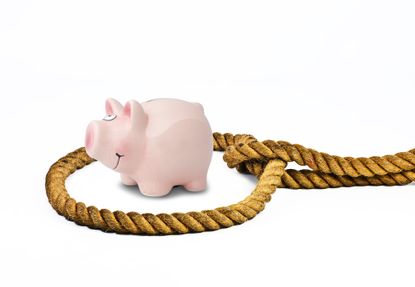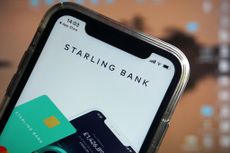Beware the savings tax trap
Higher interest rates mean that many savers may exceed their savings tax allowances. We explain clever ways to shelter your cash from the taxman


The return of interest rates that are visible to the naked eye is a very welcome change for savers who are looking to hunt down the best savings accounts.
You can now get more than 4% on easy-access accounts, and 7% if you make the best use of regular saver accounts.
Still, there is one pitfall with higher rates. Over the past decade, the need to think about the tax impact of savings became less relevant for many of us. From this tax year, that won’t be the case.
Subscribe to MoneyWeek
Subscribe to MoneyWeek today and get your first six magazine issues absolutely FREE

Sign up to Money Morning
Don't miss the latest investment and personal finances news, market analysis, plus money-saving tips with our free twice-daily newsletter
Don't miss the latest investment and personal finances news, market analysis, plus money-saving tips with our free twice-daily newsletter
Tax on savings income is charged at your marginal rate, but various allowances can shelter some of it from tax. People with little other income may be able to use some of their personal allowance of £12,570 per year to earn interest tax-free.
They may also benefit from the starting rate for savings, an allowance that begins at £5,000 and is reduced by £1 for every £1 of other income above your personal allowance.
Once your other income gets above £17,570, you no longer get the starting rate for savings, but basic-rate taxpayers have a personal savings allowance of £1,000 of interest tax-free each year.
For higher-rate taxpayers, that falls to £500, while additional-rate taxpayers get no allowance. One slightly counter-intuitive point to note about the personal savings allowance is that the money still counts when determining your tax bracket.
Consider a saver who had £49,500 in salary and £500 in savings income last year. She was just below the £50,270 higher-rate tax band and paid basic-rate tax.
This year, her interest rises to £1,500, meaning £51,000 in total income. That pushes her into the higher-rate band and reduces her personal savings allowance to £500.
What size savings pots will be hit with tax?
If you have some savings squirrelled away that are not sitting in a cash ISA, you may be surprised at how quickly you breach your personal savings allowance and have to pay tax on the interest.
A higher-rate taxpayer has a £500 tax-free personal savings allowance. If you’re earning just 1% interest, you would need a balance of £50,000 to earn interest of £500 a year. But most savers are earning more than that now, given base rate is at 5%. For someone earning 3% on their cash, they would need a balance of £17,000 to earn annual interest of £510 and bust their allowance.
The best one-year fixed-rate bond pays about 6%. You would only need to put £8,400 into that account to exceed your £500 allowance (as you’d earn £504 over the year). A higher-rate taxpayer who stashed £20,000 in a 6% account would enjoy interest of £1,200 - but would face a tax bill of £280 (£700 x 40% tax).
However, there are ways to shelter your savings from the taxman, and avoid paying tax on interest earned. We explain how.
Six options to shelter from tax
1. Use an ISA
Assuming that you still want to hold cash, rather than put it into investments or a pension, the first option is a cash individual savings account (ISA).
Interest is tax-free and you can now get 4% on a top easy-access ISA and 5% if you fix for one year. If you’re opening a new cash ISA - perhaps because the interest rate on your current one is rubbish or you don’t have a cash ISA right now - look out for ones that allow you to “transfer in” your old ISA, as this won’t count towards your annual allowance. The current allowance is £20,000, meaning this is the maximum you can pay in across your ISAs (including a stocks and shares ISA) during the 2023-24 tax year.
You could also look out for a flexible ISA, which lets you freely withdraw money and put it back within the same tax year, allowing you to take more control over your savings and cover any unforeseen expenses in life.
2. Buy premium bonds
If you’ve maxed out your £20,000 ISA limit and still have excess savings you need to shelter from the taxman, another option is National Savings & Investments’ Premium Bonds. These don’t pay interest, but hand out tax-free monthly prizes ranging from £25 to £1m. The prize fund rate is set to compete with prevailing interest rates.
This is currently 3.7% (rising to 4% in August) – but it’s skewed by the larger prizes that you are very unlikely to win. The average saver with average luck will get a much lower rate of return. Those with only a small amount are likely to end up with nothing.
However, with the maximum holding of £50,000, someone with average luck could expect to win around £1,850 per year. For somebody who would otherwise pay 40% tax on all that income, this means you will have avoided a £740 tax bill.
3. Overpay your mortgage
Mortgage rates have been soaring over the past few months: the average two-year fix is now 6.7%, while the average five-year fix is not much cheaper at 6.2%, according to the data firm Moneyfacts.
It will cause pain for many homeowners remortgaging after enjoying cheap rates over the past few years. According to the Bank of England, mortgage payments will rise by at least £500 a month for nearly one million households between the end of this year and 2026.
But if you have surplus cash now - and especially any savings that are at risk of being taxed - a smart move could be to overpay your mortgage. This will increase the equity you have in your home and could get you a cheaper rate when you come to remortgage. Overpaying also has the effect of reducing the amount of interest you pay and becoming mortgage-free faster.
Our mortgage overpayment calculator shows how your monthly repayments may change and help you decide if overpaying is worth it.
4. Pay off other bills
Do you have any bills or debts that need to be paid off? It definitely makes sense to get rid of those rather than stashing your money away in savings - only to find the taxman takes a slice of the interest.
As well as credit cards and personal loans, you may also have bills to pay like your self-assessment tax bill. Self-employed workers usually make two payments on account each year, by 31 January and 31 July. Make sure you withdraw cash from a taxable savings account (in other words, not your cash ISA or Premium Bonds) to pay it.
5. Contribute to a pension
If you’re trying to reduce the amount of money you have in savings - and therefore reduce or eliminate a tax bill - another option is to pay into a pension.
This has the benefit of building up your nest egg for retirement - and most of us aren’t saving anywhere near enough - plus you get tax relief from the government.
If you have a workplace pension scheme you may find that upping your contributions also attracts a bigger contribution from your employer - this is free money, so it’s definitely worth checking.
Alternatively, you could use a low-cost self-invested personal pension (Sipp). Be aware that pensions can’t be accessed until age 55 (rising to 57 in 2028), so this option does involve locking your money away.
Also note the annual allowance, which is the maximum you can pay into all your pension pots in one tax year - for 2023-24 it is £60,000.
6. Consider other investments
There are other ways to save tax-free, but they involve investing your money. For example, stocks and shares ISAs, venture capital trusts (VCTs) and enterprise investment schemes (EISs) are all tax-efficient. Before investing, think about your time horizon (in other words when you want to access the money), your attitude to risk and whether investing is right for you.
Jackie Hall, a partner at RSM, an accountancy firm, says taxpayers with significant savings and investments may need to think beyond their annual ISA allowance when considering ways to shelter their money. She explains: “For these individuals, it may be time to think about using an alternative wrapper to house savings and investments, which may include an (offshore or onshore) investment bond or the use of a personal investment company (PIC).
“Investments held within a bond usually grow without being directly assessed to tax on the holder. The tax charges are instead deferred until the bond is encashed, although small withdrawals, of less than 5%, can usually be made each year without giving rise to any tax implications.”
According to Hall, making investments in a PIC wrapper will result in the company being assessed to corporation tax on the underlying income and gains at a rate of not more than 25%. This is 20% less than the top rate of income tax for individuals – 45% (47% for Scottish taxpayers), which means there can be significant ongoing savings. She adds: “However, a PIC may not be suitable for short-term investment plans, as an individual will generally incur an additional layer of taxation when extracting profits from the PIC.”
Ruth is passionate about helping people feel more confident about their finances. She was previously editor of Times Money Mentor, and prior to that was deputy Money editor at The Sunday Times.
A multi-award winning journalist, Ruth started her career on a pensions magazine at the FT Group, and has also worked at Money Observer and Money Advice Service.
Outside of work, she is a mum to two young children, a magistrate and an NHS volunteer.
-
-
 Top-quality small companies with big scope for long-term growth
Top-quality small companies with big scope for long-term growthA professional investor tells us where he’d put his money. This week: Dr Gareth Blades, analyst at Amati Global Investors, highlights three favourites.
By Nicole García Mérida Published
-
 Starling Bank hikes fixed savings rate to 5.25%
Starling Bank hikes fixed savings rate to 5.25%Starling Bank has hiked the rate on its fixed savings which has shot up from 3.25% to 5.25% - but how does it compare to the rest of the market?
By Vaishali Varu Published
-
 August NS&I Premium Bond winners unveiled - have you scooped £1m?
August NS&I Premium Bond winners unveiled - have you scooped £1m?Two lucky NS&I Premium Bond winners are now millionaires in the August draw. Find out here if you are one of them
By Tom Higgins Published
-
 Savings rates more than double in a year as challenger banks top the best buy tables
Savings rates more than double in a year as challenger banks top the best buy tablesThe best savings rates have doubled - and in some cases tripled - in a year, with challenger banks offering the highest rates. While they are still no match for inflation, we look at what you could be earning.
By Ruth Emery Published
-
 Midlife MOT: what is it and who can get one?
Midlife MOT: what is it and who can get one?The government has launched an online midlife MOT to help older workers with financial planning, health guidance and career skills. But how does it work, who can get one and would you pass it?
By Ruth Emery Published
-
 Coventry Building Society launches new best easy access savings account
Coventry Building Society launches new best easy access savings accountCoventry Building Society's deal tops our easy access savings account list, but could your cash be put to better use?
By Tom Higgins Published
-
 NS&I boosts fixed-term savings rates
NS&I boosts fixed-term savings ratesThe NS&I, the government-backed savings institution has mirrored recent rate rises seen elsewhere in the market.
By Tom Higgins Published
-
 Should you let AI give you financial advice?
Should you let AI give you financial advice?Can AI fill the financial advice gap? Kalpana Fitzpatrick looks at the pros and cons of using AI to guide your finances.
By Kalpana Fitzpatrick Published
-
 Small pension pots to be consolidated, says DWP
Small pension pots to be consolidated, says DWPWorkplace pension schemes worth less than £1,000 that become “deferred” when a saver changes jobs will be consolidated under a new system
By Ruth Emery Published
-
 Watchdog summons banks to explain paltry savings rates
Watchdog summons banks to explain paltry savings ratesSavings rates trail mortgage rates - and the financial watchdog has summoned banks to a meeting amid concerns of profiteering.
By Katie Binns Last updated









